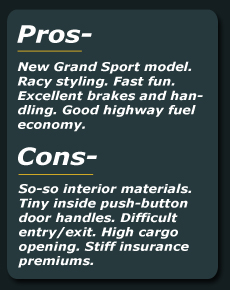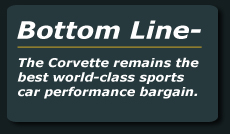2010 Chevrolet Corvette
Prices: $48,930-$106,880
I drove a new Chevrolet Corvettte from Chicago to Los Angeles on Route
66 with a friend during a week in 1987, and we never worried about the
car’s reliability. The car’s performance and long-distance
comfort were taken for granted.
However, that Corvette was supplied by Chevy Engineering and thus had
newly designed Goodyear tires that weren’t on sale yet and
couldn’t be replaced anywhere on the route if we had a flat.
Fortunately, there were none. The run-flat tires on today’s
Corvette would have been a comfort.
Chevrolet has continually sold specially equipped Corvettes in recent
years and broadens is 2010 lineup with its Grand Sport model.
Named after a legendary early 1960s Corvette race car, the Grand Sport
that I tested combines the regular Corvette’s 6.2-liter
430-horsepower V-8 with the racier 7-liter 505-horsepower ‘Vette
Z06 version’s wide-fender styling, wider track, larger brakes,
race-bred suspension and other items. They include the harder-edged
Z06’s unique wheels and taller rear spoiler. (An optional
two-mode exhaust system elevates the Grand Sport’s power rating
to 436 horses.)
The result is that the Grand Sport delivers a superb balance of road
and race track performance—not that many are likely to take it to
a track.
All Corvettes have plenty of standard comfort, convenience and safety
items. Without options, the base Corvette coupe costs $48,930 and the
base convertible version is $53,580.
The refined base version is just fine for the majority of motorists.
Close your eyes when driving it normally and you almost feel as if
you’re in a Chevy sedan. Drive it aggressively, though, and
it’s immediately clear that this is a genuine world-class
high-performance sports car. Most lack the training to drive it flat
out.
Like most Vettes, the Grand Sport can be had with a six-speed manual or
six-speed automatic transmission with a manual-shift feature. The Z06
and ZR1 come only with a six-speed manual transmission.
Opt for the automatic if you live in congested areas because the manual
has a rather stiff clutch that’s tiresome in traffic and really
isn’t needed with the smooth engine’s tremendous power and
torque.
The Grand Sport costs $54,770 in coupe form and $58,580 as a
convertible, without options. My test car was a convertible and was
packed with options that brought its bottom-line price to a hefty
$74,790.The Z06, which comes only as a coupe, is priced at $74,285,
without options but with additional standard items..
I could have done without most of the Grand Sport’s extras. (Do
you really need $270 dealer-installed pedal covers with the automatic
transmission?) In any case, there’s a good variety of more useful
options.
The top “Vette” ever built is the ferocious 200-plus mph
ZR1, which also is sold only as a coupe. It has a supercharged
638-horsepower, 7-liter V-8 and lists at $106,880 without options but
with such high-line items as ceramic brakes. That’s cheap,
considering rivals with comparable performance cost approximately
$50,000 more—and up.
The Z06 and ZR1 come just as coupes for more body rigidity to enhance
their ultra-high performance, although my test Grand Sport convertible
was rattle-free.
Estimated fuel economy for the standard Corvette is 15-16 mpg in the
city and a sparkling (for its performance) 25-26 on highways. The Z06
gets a little less and the super-horsepower ZR1 provides 14 city and 20
highway. High-octane fuel is recommended for all models.
New features for 2010 Corvettes include standard side air bags,
standard launch control with manual-transmission models for the fastest
takeoffs, revised automatic transmission paddle shift control for
easier return to automatic mode and a “Z06 3LZ” package
that includes power sport seats and a power passenger seat.
The 2010 Corvette is considerably better than our 1987 “Route
66” Corvette because ‘Vettes have undergone constant
improvements since introduced in 1953.
The original 1953-55 Corvette was gorgeous, but was essentially a
General Motors auto show “dream car” with futuristic
styling and wasn’t very fast or comfortable.
The much faster 1956-57 model had cleaner, superb styling, but drove
like a truck by today’s standards. The 1960s Corvette Sting Rays
were a major leap forward, at least without the optional big V-8s that
had awesome power but were nose-heavy and too much for the that
era’s skinny tires.
And so it goes with America’s most popular sports car, which has
survived good and bad economic times.
One reason for the Corvette’s popularity has been its
affordability. It was never cheap, but almost any financially
responsible person with a regular job could afford one.
The Corvette got slicker styling in 2005, when its concealed headlights
vanished. But it’s still a low-slung “drop-in,
climb-out” car that calls for some athletic moves. And its long
doors make it awkward in tight spots.
Gauges can be quickly read, but the tiny interior push-button door
handles are a nuisance. While improved from earlier models, interior
materials still don’t measure up to the car’s price.
Steering, braking and handling of all Corvette versions is
superb—helped by stability and traction controls. And the ride is
comfortable for most models. You can even order the base model with a
sophisticated $1,995 Magnetic Selective Ride Control, which provides a
driver-selectable “responsive” suspension.












Even the convertible has decent trunk room, but the
cargo opening is high and there is little cabin storage space.
For many who don’t want an exotic-car name badge, the Corvette is
the ultimate sports car. Insurance premiums are stiff, but maintenance
costs are commendably low, which is something that can’t be said
for many Corvette rivals.







